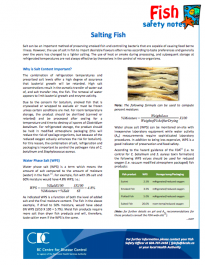Application of Appropriate Technology for Artisanal Fish Salting
Technology can be used to influence the salt content and control insect infestation. Both of which cause food loss and waste (FLW).
Water Phase Salt
Water Phase Salt
The most commonly used methods of salting fish are liquid brining and dry salting. In each case, the amount and rate of salt absorption are affected by a variety of factors.
Water phase salt (WPS) is a term which means the amount of salt compared to the amount of moisture (water) in the flesh. WPS can be monitored on-site with inexpensive laboratory equipment while water activity (Aw) measurements require sophisticated laboratory procedures. In addition to being less expensive, WPS is a good indicator of preservation and food safety.
Sufficient salt levels in the final product are important for food safety, product preservation and consumer preferences. Due to the many variables, it is critical to develop a processing formula for each species of fish and to ensure that it is rigidly followed. Regular salt level testing of the final product should be an integral part of the process.
Because it is not practical to routinely measure water phase salt, the processor's critical limit specifies the batch process parameters (brine salt level, amount of product, brine time and temperature) that are easy to measure and necessary to ensure that there is at least 3.5% water phase salt in the finished product. In this situation, an appropriate verification procedure would be to periodically sample the finished product and have it tested to "verify" that the water phase salt concentration is at least 3.5%.
Insect Infestation
Insect Infestation
The use of salt in traditional fish processing is primarily as a preservation and processing aid but is also considered to have a secondary role in preventing blowfly infestation of the fish during sun-drying.
Salt content of over 10% can reduce beetle infestation during storage. However, high salt content can have a detrimental effect on consumer acceptance.
A systems-based strategy was field tested in India. During the course of the trials, 24 processing cycles were monitored under both monsoon and dry season conditions. Field trials data showed real benefits associated with the adoption of the interventions selected by the processors (e.g. salting tank lids, raised drying racks, more hygienic fish handling practices, etc). Infestation and loss levels experienced by processors using the interventions have been significantly and consistently lower than those experienced by the control processors. Since completion of the field trials, the processors have continued to use the blowfly control interventions and feedback has been highly positive, particularly in respect of salting tank lids, drying racks and submerging frames. Reductions in infestation and losses have been translated into economic benefits.
Key Publications
Description of the importance effect of salt and its uptake. | |
Project report on the development of a prototype blowfly control strategy that is appropriate for use by resource - poor fish processors in tropical countries, and produce related training / extension materials. |
More Resources
More Resources
31 October 2023
05 September 2023













